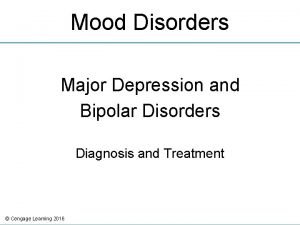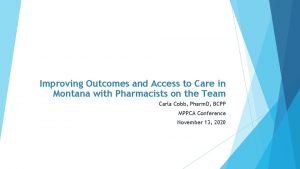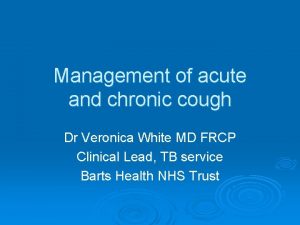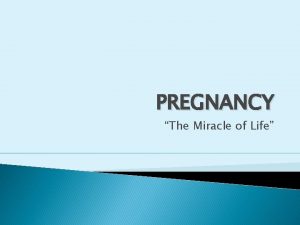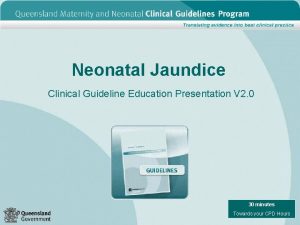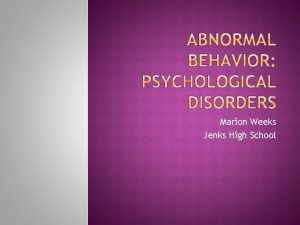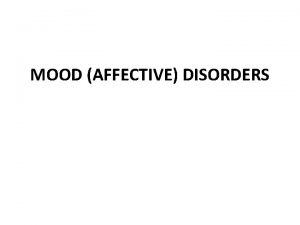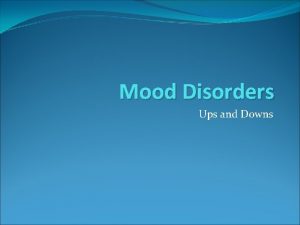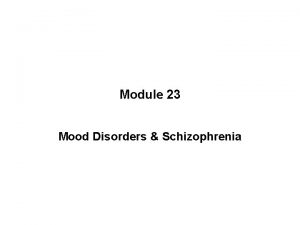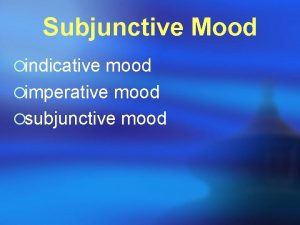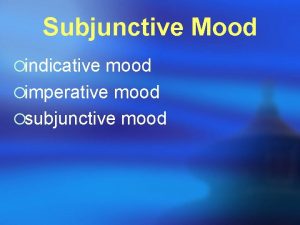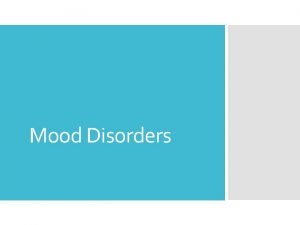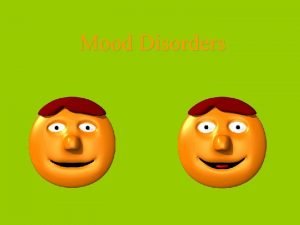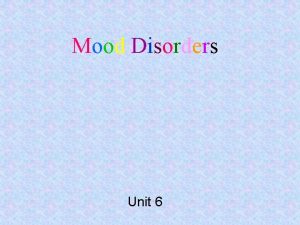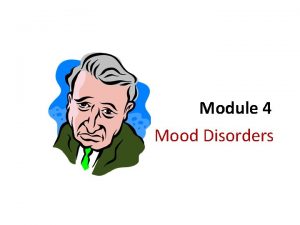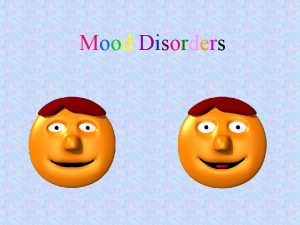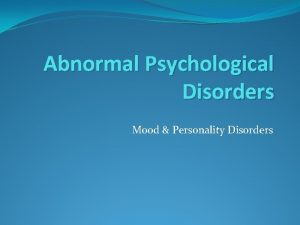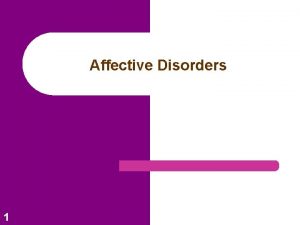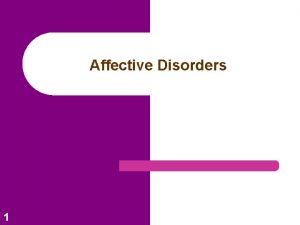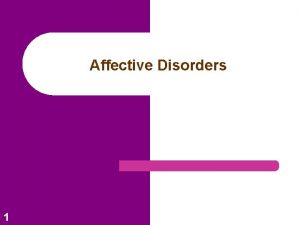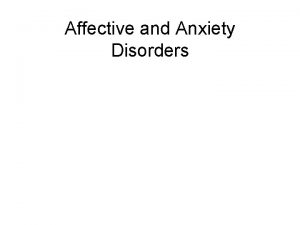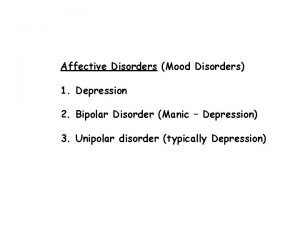Mood Affective Disorders Marion Weeks Jenks High School



















- Slides: 19

Mood (Affective) Disorders Marion Weeks Jenks High School

Mood Disorders in general � This category of mental disorders has significant and chronic disruption in mood as the predominant symptom. � This causes impaired cognitive, behavioral, and physical functioning. � Mood disorders are differentiated from normal moods on the basis of duration, intensity, and absence of cause. ◦ For example, two weeks of continued symptoms with high levels of intensity and with no precipitating cause indicates a major depressive episode.

Mood Disorders in general � Prevalence of mood disorders � 1. Mood disorders are among the most common of all psychological disorders, affecting about 12 million Americans in any given year. � 2. Mood disorders are more common in women than in men. � 3. The greatest risk of developing major depression occurs between the ages of 15 - 24 and 35 -44. � 4. Episodes recur in one half of all cases and last at least two weeks.

Mood Disorders in general � Most common is depression. � Depression is the number 1 reason people seek mental health services. � Mild depression (as we all experience occasionally) is adaptive – when times are tough, depression slows us down, avoids attracting predators, forces us to reassess our lives, and evokes support. � Depression is considered a mental illness when it ceases to be adaptive -- when the behavior interferes with our survival.

Facts About Depression � Depression tends to be self-sustaining � Women are twice as likely to report depression than men. � Stressful � Rates events often precede depression of depression have increased with each generation (not just in America)

Facts About Depression � Depression strikes at younger age now than in previous generations (not just in America) � Indication is that increase is real, and not just that people are more likely to report depression than before. � Young adults (18 -24) are at the highest risk for developing depression, particularly those who have been depressed before. � Ironically, few people commit suicide in the midst of depression because they lack initiative and energy. � Suicide risk is highest when people first start to recover.

Major Depression � � Emotional symptoms involve feelings of sadness, hopelessness, and guilt. They also involve feeling emotionally disconnected from other people. Behavioral symptoms include a dejected, unsmiling, downcast demeanor; slowed movements and speech; tearfulness and spontaneous crying; and a loss of interest or pleasure in one's usual activities, including sex and eating. Cognitive symptoms involve difficulty thinking, concentrating, and remembering; global negativity and pessimism; and suicidal thoughts or preoccupation with death. Physical symptoms include changes in appetite resulting in weight gain or loss; constipation; sleep disturbances, such as insomnia, oversleeping, or early waking; chronic, vague aches and pains; and loss of energy, or restless, fidgety activity.

Major Depressive Disorder � Signs of depression (feelings of worthlessness, loss of interest in family, friends, and activities, lethargy, change in eating patterns, thoughts of death, inability to concentrate, sense of hopelessness, dissatisfaction with your life) last 2 weeks or more. � Usually goes away (even without treatment, although treatment can speed up recovery) in under 6 months

Other depressed mood disorders � Dysthymic disorder ◦ A long-term, low-level depression; not debilitating ◦ Characterized by low self-esteem and a sense of hopeless all day almost every day for at least two years. ◦ People with dysthymia may also experience low energy, indecisiveness, insomnia or excessive sleeping, and a change in appetite. ◦ Involves chronic, low-grade feelings of depression that produce subjective discomfort but, unlike major depression, does not seriously impair one's ability to function.

Bipolar disorder � Alternating episodes of major depression and mania. � Behaviors associated with manic episode – excessively talkative, over reactive, elated, irritable, little need for sleep, often say their minds are “racing” and jump around from subject to subject when talking, easily distracted, fewer sexual inhibitions. � VERY high self-esteem and optimism leads to poor judgment (spending a lot of money on a shopping spree, taking unnecessary risks)

Bipolar disorder � Occurs in less than 1% of population � Occasionally associated with psychosis (such as hallucinations and delusions); severe forms like these are occasionally misdiagnosed as schizophrenia

Characteristics of mania � 1. Emotional symptoms, such as euphoria, expansiveness, and excitement (feeling "on top of the world"). � 2. Behavioral symptoms, such as out-of-character energy or activity, frenzied, disorganized goaldirected activity, rapid-fire speech, spending sprees and illegal acts, and severely disrupted sleep patterns often resulting in little or no sleep over a number of days. � 3. Cognitive symptoms, such as wildly inflated selfesteem, grandiosity (sometimes involving delusional beliefs), easy distractibility leading to a flight of ideas in which thoughts rapidly and loosely shift, irritability, and verbal abusiveness if grandiose ideas are questioned.

Prevalence and course � 1. Annually about 2 million Americans suffer from bipolar disorder. � 2. Onset typically occurs in the early twenties. � 3. The disorder affects men and women at the same rate. � 4. It is a recurring, chronic disorder that generally responds favorably to drug therapy.

Cyclothymic disorder �A milder, but chronic form of bipolar disorder, involves moderate but frequent mood swings. � People with the disorder are perceived as extremely moody, unpredictable, and inconsistent.

Explaining affective disorders Biological Perspective � Mood disorders run in families � Twins studies indicate genetic influence on the disease � Decreased levels of norepinephrine, serotonin, and dopamine are all associated with depression � Drugs that alleviate mania reduce norepinephrine levels � Drugs that alleviate depression increase levels of one or all three � ◦ “tricyclic” – class of antidepressants that increase levels of all 3 ◦ “SSRI’s” – (selective serotonin reuptake inhibitors) increase serotonin specifically (Prozac, Zoloft, Paxil) Physical exercise (which reduces depression) increases serotonin levels � Frontal lobe activity is decreased in depressed patients and increased in manic patients �

Explaining affective disorders � Behavioral Perspective � Stresses the role of reinforcement. ◦ 1. Depressed people may lack the social skills needed to gain normal social reinforcement from others. ◦ 2. Thus, a vicious cycle develops in which reduced social reinforcement leads to depression, and depressed behavior further reduces social reinforcement.

Explaining affective disorders � Social-Cognitive Perspective ◦ Depression causes negative thinking AND negative thinking causes depression. ◦ Stress that the way people think can result in depression. ◦ Perfectionists set themselves up for depression through irrational self-demands they may not be able to meet. ◦ Paying attention to negative information, being highly self-critical, being pessimistic about the future, and focusing on the cause of the negative mood all contribute to depression.

Explaining affective disorders � Self-defeating beliefs (we believe were are worthless, we begin to act like we are worthless) � May arise from learned helplessness � Attributions ◦ Depressed people are more likely to explain bad events in terms that are stable (it’s going to last forever”, global (it affects everything), and internal (its my fault). ◦ Depression is less common is collectivist cultures – maybe because of social supports or maybe because people are less likely to feel individually responsible for bad events

Explaining affective disorders � Mood-congruent memory � Negative mood causes negative thoughts ◦ Interesting experiment ◦ After losing their basketball game fans were more likely (than after a win)to predict not only that the team would fair poorly in future games, but also that they would fair poorly at several tasks (throwing darts, solving puzzles, getting a date)
 Ttcu foolproof
Ttcu foolproof Dsm 5 mood disorder
Dsm 5 mood disorder Jenks pre k enrollment
Jenks pre k enrollment Jenks course planning guide
Jenks course planning guide Bryan jenks
Bryan jenks Jenks east intermediate
Jenks east intermediate Jenks natural breaks optimization python
Jenks natural breaks optimization python Jenks west elementary building f
Jenks west elementary building f Amy jenks state of montana
Amy jenks state of montana Crescenta valley high school graduation 2021
Crescenta valley high school graduation 2021 Haltom high school summer school
Haltom high school summer school Words that rhyme with weeks
Words that rhyme with weeks Total annual cost of inventory formula
Total annual cost of inventory formula Weeks of supply formula
Weeks of supply formula Antenatal investigations
Antenatal investigations Max caplin clinic
Max caplin clinic Doença
Doença 4 weeks before christmas
4 weeks before christmas What is amniotic fluid
What is amniotic fluid Phototherapy for jaundice guidelines
Phototherapy for jaundice guidelines

